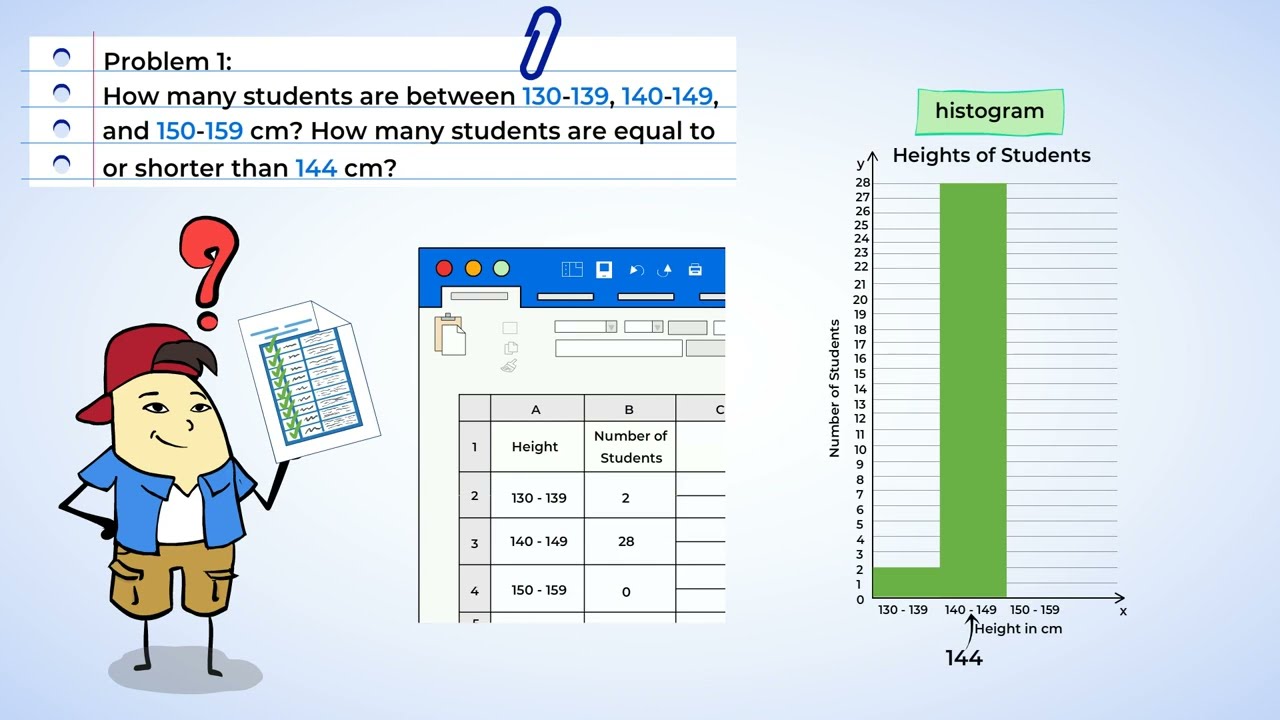
Interpreting Dot Plots and Histograms
Interactive Video
•
Mathematics
•
6th - 10th Grade
•
Hard
+1
Standards-aligned
Lucas Foster
FREE Resource
Standards-aligned
Read more
10 questions
Show all answers
1.
MULTIPLE CHOICE QUESTION
30 sec • 1 pt
What is the primary purpose of using graphs in data analysis?
To increase the amount of data
To visualize mathematical data clearly
To confuse the audience
To make the data look more complex
Tags
CCSS.6.SP.B.4
CCSS.HSS.ID.A.1
2.
MULTIPLE CHOICE QUESTION
30 sec • 1 pt
What characteristic of Chen's class height data can be observed from the dot plot?
The data is skewed to the right
The data shows no clear pattern
The data is skewed to the left
The data is symmetrical
3.
MULTIPLE CHOICE QUESTION
30 sec • 1 pt
What is the most common height in Chen's class according to the dot plot?
149 centimeters
136 centimeters
140 centimeters
143 centimeters
Tags
CCSS.2.MD.D.9
4.
MULTIPLE CHOICE QUESTION
30 sec • 1 pt
Why might a histogram be preferred over a dot plot in some cases?
It groups data into bins for a clearer overview
It shows exact values for each data point
It requires less space to draw
It is easier to identify outliers
5.
MULTIPLE CHOICE QUESTION
30 sec • 1 pt
What does each bar in a histogram represent?
The maximum value in the data set
A range of data grouped into bins
A single data point
The average of a group of data
Tags
CCSS.6.SP.B.4
CCSS.HSS.ID.A.1
6.
MULTIPLE CHOICE QUESTION
30 sec • 1 pt
How can you determine the most frequent height range in Chen's class from the histogram?
By finding the tallest bar
By measuring the width of the bars
By looking for outliers
By counting the number of bins
Tags
CCSS.6.SP.B.4
CCSS.HSS.ID.A.1
7.
MULTIPLE CHOICE QUESTION
30 sec • 1 pt
Why can't the exact number of students shorter than 140 centimeters be determined from the histogram?
Because the histogram is incorrectly drawn
Because the histogram only shows data above 140 centimeters
Because the data is not accurate
Because the histogram does not show individual data points
Tags
CCSS.2.MD.D.9
Create a free account and access millions of resources
Similar Resources on Wayground

11 questions
Exploring Discrete and Continuous Data in Grocery Stores
Interactive video
•
6th - 10th Grade

11 questions
Creating and Interpreting Histograms
Interactive video
•
6th - 10th Grade

11 questions
Exploring Dot Plots and Histograms
Interactive video
•
6th - 10th Grade

11 questions
Data Visualization Techniques and Limitations
Interactive video
•
6th - 8th Grade

11 questions
Graph Types and Their Uses
Interactive video
•
6th - 8th Grade

11 questions
Interpreting and Comparing Histograms
Interactive video
•
6th - 10th Grade

11 questions
Comparing Bar Graphs and Histograms
Interactive video
•
6th - 10th Grade
Popular Resources on Wayground

10 questions
Lab Safety Procedures and Guidelines
Interactive video
•
6th - 10th Grade

10 questions
Nouns, nouns, nouns
Quiz
•
3rd Grade

10 questions
9/11 Experience and Reflections
Interactive video
•
10th - 12th Grade

25 questions
Multiplication Facts
Quiz
•
5th Grade

11 questions
All about me
Quiz
•
Professional Development

22 questions
Adding Integers
Quiz
•
6th Grade

15 questions
Subtracting Integers
Quiz
•
7th Grade

9 questions
Tips & Tricks
Lesson
•
6th - 8th Grade
Discover more resources for Mathematics

15 questions
Subtracting Integers
Quiz
•
7th Grade

22 questions
Adding Integers
Quiz
•
6th Grade

20 questions
Multiplying and Dividing Integers
Quiz
•
7th Grade

20 questions
Perfect Squares and Square Roots
Quiz
•
7th Grade

20 questions
Adding and Subtracting integers
Quiz
•
7th Grade

20 questions
Adding and Subtracting Integers
Quiz
•
6th Grade

20 questions
Adding and Subtracting Integers
Quiz
•
6th - 7th Grade

21 questions
Convert Fractions, Decimals, and Percents
Quiz
•
6th Grade